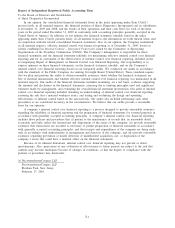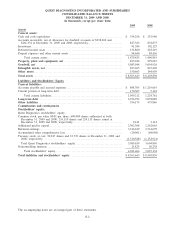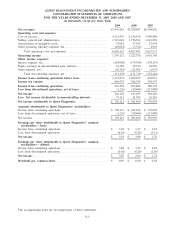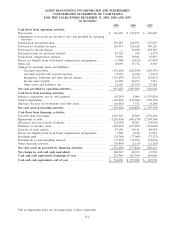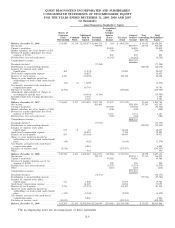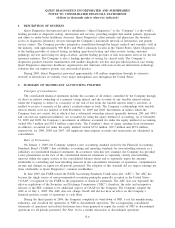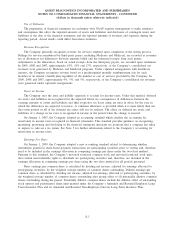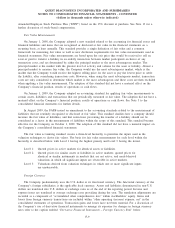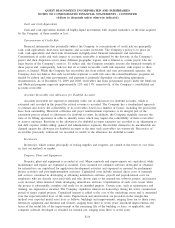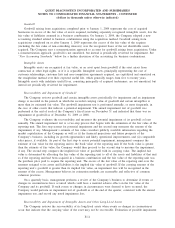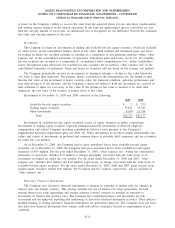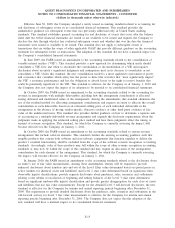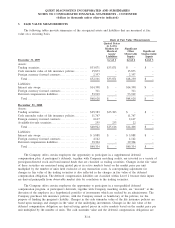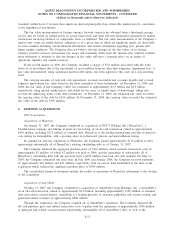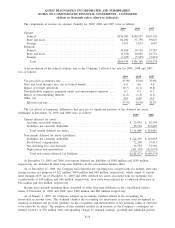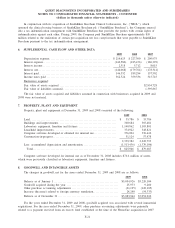Quest Diagnostics 2009 Annual Report Download - page 81
Download and view the complete annual report
Please find page 81 of the 2009 Quest Diagnostics annual report below. You can navigate through the pages in the report by either clicking on the pages listed below, or by using the keyword search tool below to find specific information within the annual report.Goodwill
Goodwill arising from acquisitions completed prior to January 1, 2009 represents the cost of acquired
businesses in excess of the fair value of assets acquired, including separately recognized intangible assets, less the
fair value of liabilities assumed in a business combination. On January 1, 2009, the Company adopted a new
accounting standard related to business combinations using the acquisition method. Goodwill arising from
acquisitions completed on or after January 1, 2009 represents the excess of the fair value of the acquiree
(including the fair value of non-controlling interests) over the recognized bases of the net identifiable assets
acquired. The Company uses a nonamortization approach to account for goodwill arising from acquisitions. Under
a nonamortization approach, goodwill is not amortized, but instead is periodically reviewed for impairment. See
“New Accounting Standards” below for a further discussion of the accounting for business combinations.
Intangible Assets
Intangible assets are recognized at fair value, as an asset apart from goodwill if the asset arises from
contractual or other legal rights, or if it is separable. Intangible assets, principally representing the cost of
customer relationships, customer lists and non-competition agreements acquired, are capitalized and amortized on
the straight-line method over their expected useful life, which generally ranges from five to twenty years.
Intangible assets with indefinite useful lives, consisting principally of acquired tradenames, are not amortized, but
instead are periodically reviewed for impairment.
Recoverability and Impairment of Goodwill
The Company reviews goodwill and certain intangible assets periodically for impairment and an impairment
charge is recorded in the periods in which the recorded carrying value of goodwill and certain intangibles is
more than its estimated fair value. The goodwill impairment test is performed annually, or more frequently, in
the case of other events that indicate a potential impairment. The annual impairment test of goodwill was
performed at the end of each of the Company’s fiscal years on December 31 and indicated that there was no
impairment of goodwill as of December 31, 2009 or 2008.
The Company evaluates the recoverability and measures the potential impairment of its goodwill at least
annually. The annual impairment test is a two-step process that begins with the estimation of the fair value of the
reporting unit. The first step screens for potential impairment and the second step measures the amount of the
impairment, if any. Management’s estimate of fair value considers publicly available information regarding the
market capitalization of the Company as well as (i) the financial projections and future prospects of the
Company’s business, including its growth opportunities and likely operational improvements, and (ii) comparable
sales prices, if available. As part of the first step to assess potential impairment, management compares the
estimate of fair value for the reporting unit to the book value of the reporting unit. If the book value is greater
than the estimate of fair value, the Company would then proceed to the second step to measure the impairment,
if any. The second step compares the implied fair value of goodwill with its carrying value. The implied fair
value is determined by allocating the fair value of the reporting unit to all of the assets and liabilities of that unit
as if the reporting unit had been acquired in a business combination and the fair value of the reporting unit was
the purchase price paid to acquire the reporting unit. The excess of the fair value of the reporting unit over the
amounts assigned to its assets and liabilities is the implied fair value of goodwill. If the carrying amount of the
reporting unit’s goodwill is greater than its implied fair value, an impairment loss will be recognized in the
amount of the excess. Management believes its estimation methods are reasonable and reflective of common
valuation practices.
On a quarterly basis, management performs a review of the Company’s business to determine if events or
changes in circumstances have occurred which could have a material adverse effect on the fair value of the
Company and its goodwill. If such events or changes in circumstances were deemed to have occurred, the
Company would perform an impairment test of goodwill as of the end of the quarter, consistent with the annual
impairment test, and record any noted impairment loss.
Recoverability and Impairment of Intangible Assets and Other Long-Lived Assets
The Company reviews the recoverability of its long-lived assets when events or changes in circumstances
occur that indicate that the carrying value of the asset may not be recoverable. Evaluation of possible impairment
F-11
QUEST DIAGNOSTICS INCORPORATED AND SUBSIDIARIES
NOTES TO CONSOLIDATED FINANCIAL STATEMENTS - CONTINUED
(dollars in thousands unless otherwise indicated)


